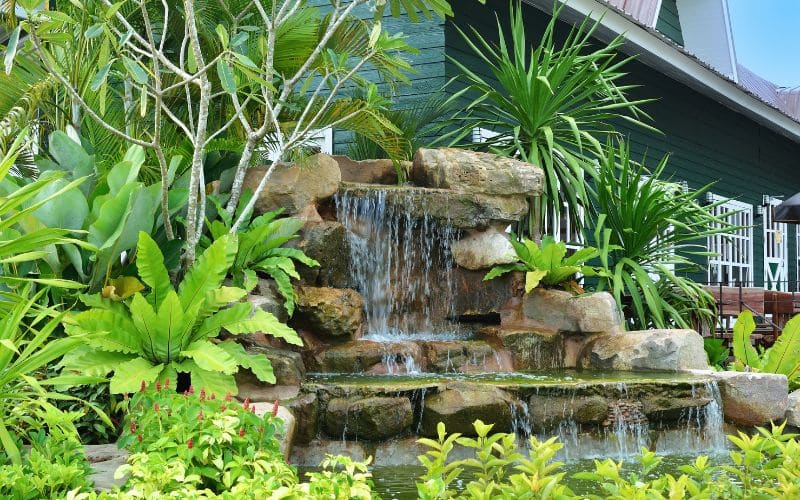
How Waterfall Ponds Enhance Your Landscape
Creating a mesmerizing focal point
A well-designed waterfall pond instantly grabs attention, instantly adding depth and intrigue to any garden. The movement of water, combined with natural and artificial elements, can create a multi-sensory experience that leaves a lasting impression on visitors.
Encouraging a healthier ecosystem
Water features like waterfall ponds not only increase water circulation, but they also help create microclimates and foster habitats for various organisms. By attracting beneficial insects, birds, and other wildlife, your garden can become a haven for biodiversity.
Reducing noise pollution
Waterfall ponds are particularly effective at masking unpleasant noises, such as traffic, equipment, or other environmental disturbances. The calming sound of trickling water helps create a serene atmosphere where you can unwind and enjoy nature.
Improving air quality
The presence of a waterfall pond can aid in purifying the air around your garden. As water cascades over the rocks, it generates negative ions, which have been shown to help reduce airborne pollutants and allergens and improve overall air quality.
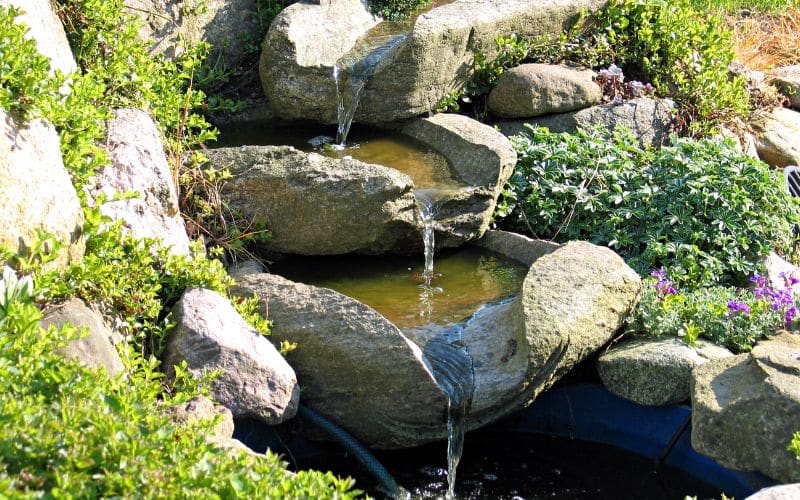
Designing a Waterfall Pond: Matters to Consider
Size up your space and garden
First things first: check out your available space and assess your garden’s key features. Pay attention to the size of your backyard, existing greenery, and terrain slope.
Sizing and styling your pond
Pick the ideal size and style for your pond by considering what blends with your landscape. Ask yourself if you prefer a natural, modern, or formal look.
Materials and methods matter
Opt for materials and construction approaches that achieve both stunning aesthetics and reliable structure. Keep in mind aspects like durability, upkeep, and harmonizing elements.
Safety comes first
Don’t forget to design a pond with safety in mind. Contemplate aspects like fences, slip-resistant surfaces, and easy access.
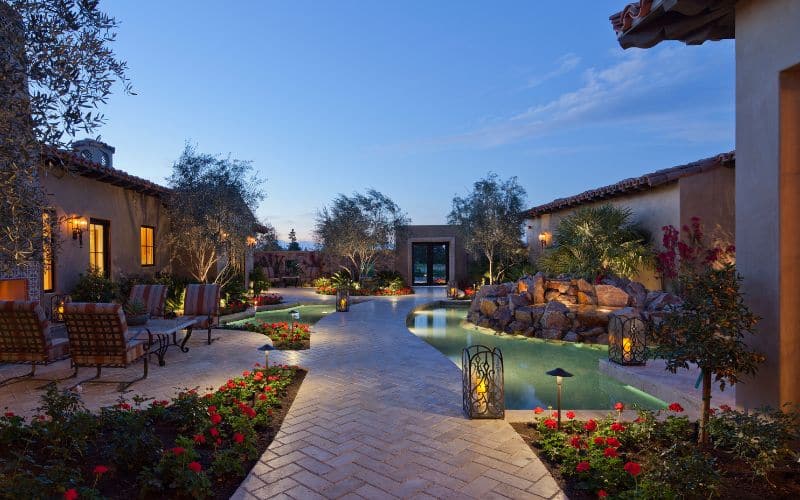
The Ideal Waterfall Pond Design for Your Landscape
Examine your existing landscape features
Study the layout and style: Analyze the existing layout and style of your landscape, considering aspects such as architecture, hardscaping, and existing water elements that could be incorporated into your waterfall pond design.
Identify existing vegetation and shade: Take note of the sunlight patterns and the degree of shade offered by trees and other tall structures. This information is vital for selecting appropriate plants and determining the pond’s position to optimize its living conditions.
Structural and decorative enhancements: Determine if some pergolas, benches, or sculpture could be integrated into the waterfall pond design, enhancing the overall composition and creating visual harmony.
Viewing angles and focal points: Examine your garden from multiple vantage points to identify optimal locations for your waterfall pond. Positioning your water feature in a spot where it can be enjoyed from several viewing angles will maximize its impact.
Bring in local plants to enrich your design
Choose native species: Opt for plants native to your area to create a natural and cohesive design. Native plants are typically better adapted to local weather conditions, have lower maintenance requirements, and can be instrumental in supporting regional wildlife.
Optimize planting zones: Utilize various planting zones around your waterfall pond based on the plants’ specific water and sunlight requirements. Some plants may need consistently moist soil, while others might prefer drier conditions.
Layer the vegetation: Layer your pond vegetation to create a visually appealing space with varying heights, textures, and colors. Use a combination of tall, medium, and low-growing plants to provide the illusion of depth and natural beauty around your waterfall pond.
Consider aquatic plants: Incorporate aquatic plants into your pond design to oxygenate the water, promote beneficial bacteria growth, and provide shelter for fish and other wildlife. Pickerelweed, water lilies, and water hyacinths are a few examples of attractive aquatic plants that can contribute to a healthy and beautiful pond ecosystem.
Consult local agencies or nurseries: Seek advice from local experts, such as nurseries or environmental organizations who have knowledge about regional plants. They can suggest the best native plant species for your waterfall pond, offering vital insights to help you create a successful landscape design.
Top 5 Components of an Outstanding Waterfall Pond Design
Dynamic waterfalls and cascades
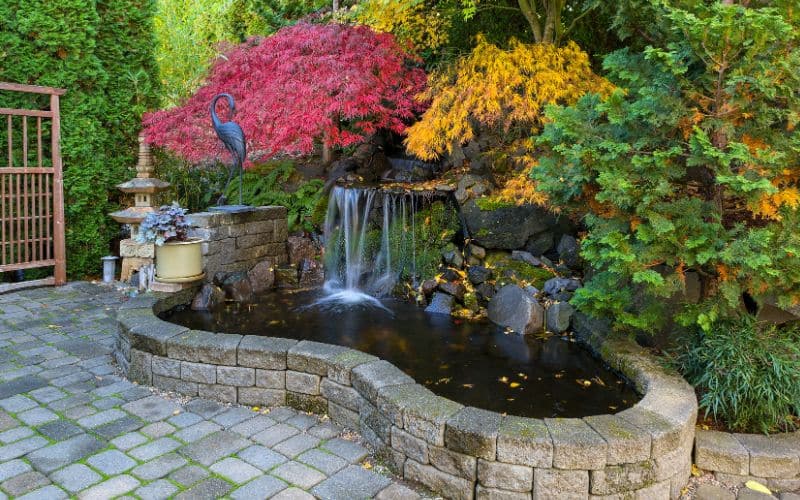
Add character to your pond with waterfalls of various heights and widths, creating a breathtaking blend of visual charm and soothing sounds.
Intriguing pond edges and aquatic flora
Utilize pond edges and aquatic plants to soften the pond’s contours and bring in a mix of textures and colors.
Clever lighting for nighttime charm
Illuminate your pond and its surroundings with subtle, energy-efficient lights that emphasize waterfalls and plants at night.
Living ecosystem with fish and wildlife
Breathe life into your pond by incorporating fish and local wildlife to create a gorgeous and functional outdoor feature.
Cozy seating for pond gazing
Arrange some comfortable seating around the pond, so you and your guests can appreciate the beauty and peace your waterfall pond offers.
DIY or Professional Waterfall Pond Installation: Pros and Cons
Weighing your options
Ponder your financial situation, availability, and skills when choosing between DIY or professional installation.
Budgeting and cost planning
Before committing to your pond project, do some research on material, labor, and maintenance costs.
Finding a skilled landscape designer
Look for a professional landscape designer with a commendable portfolio and solid communication skills to realize your vision.
Nurturing Your Waterfall Pond: Care and Maintenance
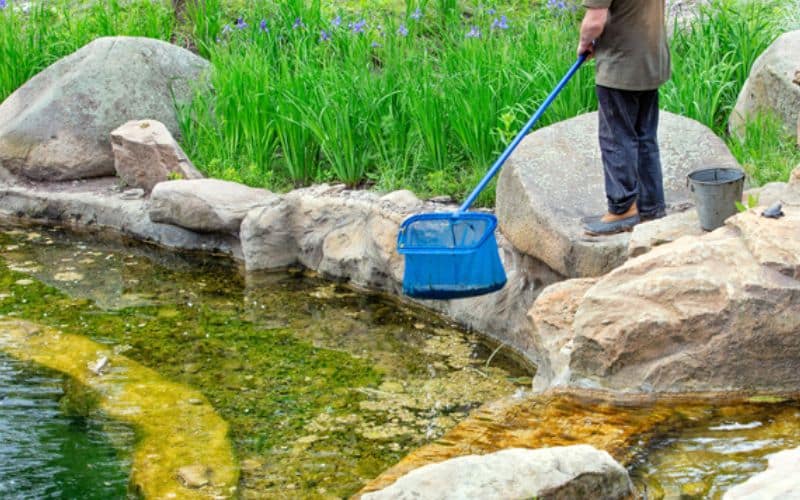
A clean and healthy pond is a top priority
Frequent upkeep is vital for the visual appeal and longevity of your waterfall pond. Keep an eye on water quality, restore nutrients, and clear away debris and algae.
Ready your pond for different seasons
Stay vigilant with tasks suited for each season, like adjusting water levels, winterizing, and prepping for spring and summer.
Take care of plants and aquatic creatures
Attend to the welfare of your pond’s flora and fauna. Provide adequate nutrients, maintain optimal water quality, and encourage a harmonious ecosystem.
Conclusion
Investing time and thought into creating a perfect waterfall pond brings a sense of serenity to your home for years to come.
Designing your waterfall ponds ideas demands careful consideration of elements like space, materials, and aesthetics. A meticulous approach will lead to a spectacular water feature that adds both beauty and tranquility to your outdoor space.
Dive into creating your personalized tranquil oasis with a waterfall pond that fits your unique landscape. The result will be a delightful and impressive addition to your garden that you and your visitors will cherish for years to come.
Waterfall Ponds FAQs

What can I expect to spend on building a waterfall pond in my backyard?
Costs for a waterfall pond project can vary greatly. Factors like size, design, materials, and whether you choose DIY or a professional installation will influence the price. It could range from a few hundred dollars for a simple DIY pond to thousands for a professionally designed custom installation.
Which fish species are suitable for my waterfall pond?
Some popular choices for ponds are goldfish, koi, and mosquito fish. Be sure to study the specific needs of your desired species and how they’ll adapt to your pond conditions and local climate.
How can I make my waterfall pond eco-friendly?
Go green by using energy-efficient pumps and lights, planting native species, avoiding chemical additives, fostering biodiversity, and maintaining proper water quality.
How much maintenance does a waterfall pond require?
Maintenance needs will vary depending on factors like pond size, design, and the number of plants and animals. Expect regular tasks to include water quality monitoring, nutrient replenishment, debris removal, and seasonal care.
Can having a waterfall pond increase my home’s value?
A well-designed and well-maintained waterfall pond might enhance your property value by boosting curb appeal and offering a unique feature that appeals to prospective buyers.
Colin Macmillan is a seasoned entrepreneur and the CEO of Riverwood Landscape, a leading landscaping company based in Canada. He has been at the helm of the company since leaving high school, demonstrating his strong leadership skills and business acumen.
Colin’s expertise lies in various aspects of landscaping, including lawn care, interlocking, sod installation, and commercial maintenance. His hands-on approach and dedication to the craft have been instrumental in building Riverwood Landscape into a reputable brand.
One of his most notable achievements is the creation of a successful landscape franchise that services multiple locations. This accomplishment underscores his strategic thinking and ability to scale operations effectively.
Colin has also had the privilege of working with Guelph Hospital for landscaping and maintenance, a testament to the trust and reliability that his company has earned over the years.
His professional mission is to offer the best services and experiences for customers, a goal that he tirelessly pursues. Colin’s commitment to excellence and customer satisfaction continues to drive the growth and success of Riverwood Landscape.








